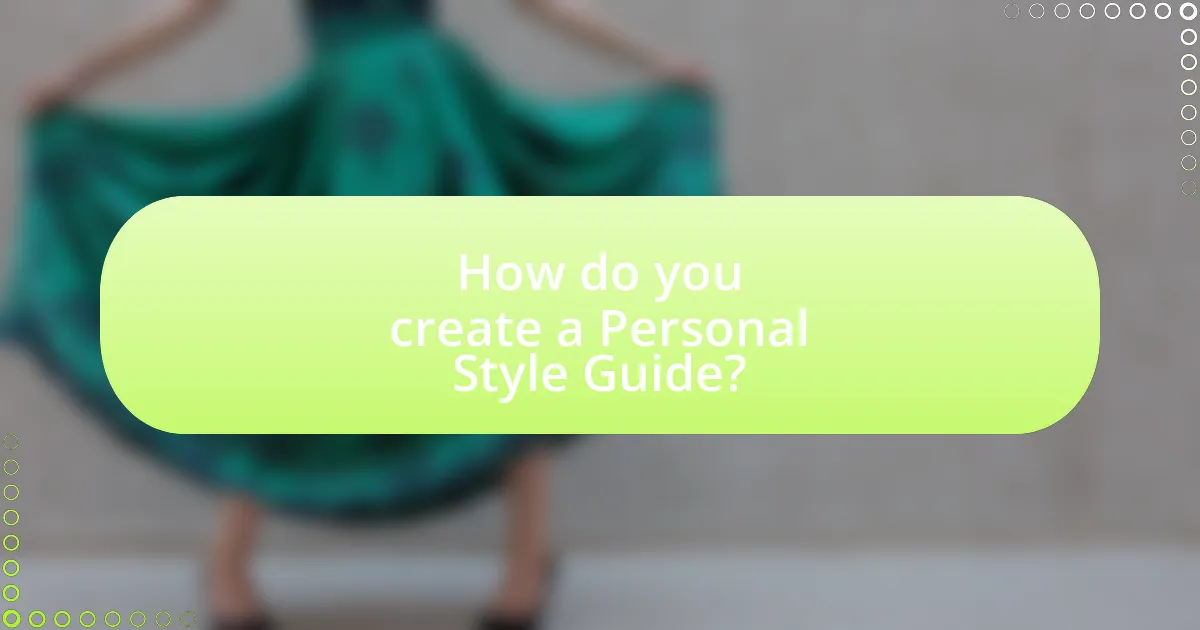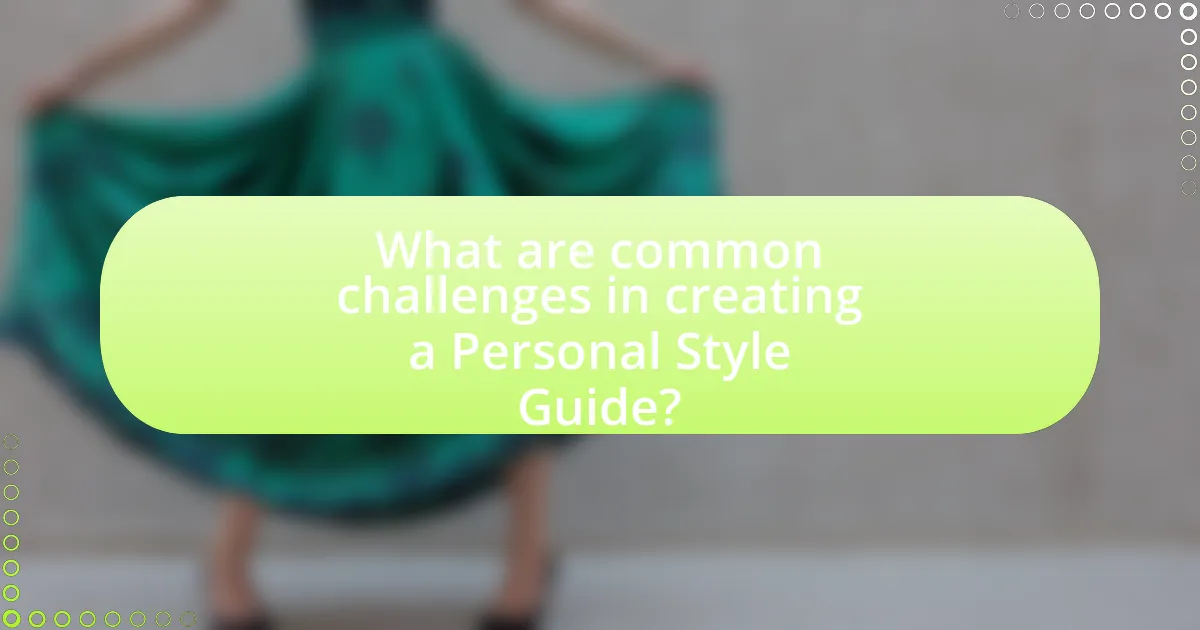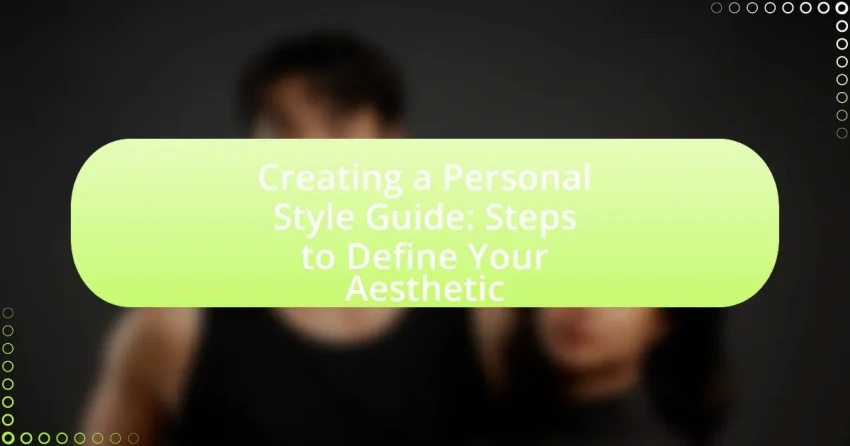A Personal Style Guide is a curated document that outlines an individual’s aesthetic preferences, including fashion choices, color palettes, and design elements, serving as a reference for maintaining consistency in personal branding and visual identity. The article details the importance of a Personal Style Guide in defining one’s aesthetic, influencing personal branding, and streamlining decision-making in fashion and design. Key components of a Personal Style Guide include visual identity, typography, color palette, imagery, and tone of voice, all of which contribute to a cohesive personal style. Additionally, the article provides practical steps for creating, refining, and implementing a Personal Style Guide, as well as strategies for overcoming common challenges in the process.

What is a Personal Style Guide?
A Personal Style Guide is a curated document that outlines an individual’s aesthetic preferences, including fashion choices, color palettes, and design elements. This guide serves as a reference to maintain consistency in personal branding and visual identity. It often includes specific examples of styles, preferred materials, and inspirations that reflect the individual’s unique taste. By defining these elements, a Personal Style Guide helps streamline decision-making in fashion and design, ensuring that choices align with the established aesthetic.
Why is a Personal Style Guide important for defining your aesthetic?
A Personal Style Guide is important for defining your aesthetic because it provides a clear framework for your visual and stylistic choices. This guide helps individuals articulate their preferences, ensuring consistency in their fashion, decor, and overall presentation. By outlining specific colors, patterns, and styles that resonate with one’s identity, a Personal Style Guide serves as a reference point that simplifies decision-making and enhances self-expression. Research indicates that having a defined personal style can boost confidence and improve personal branding, making it a valuable tool for anyone looking to establish a cohesive aesthetic.
How does a Personal Style Guide influence personal branding?
A Personal Style Guide significantly influences personal branding by providing a consistent framework for visual and communicative elements that represent an individual. This consistency helps to establish a recognizable identity, making it easier for audiences to connect with and remember the brand. For instance, a well-defined color palette, typography, and imagery can evoke specific emotions and associations, reinforcing the brand’s message and values. Research indicates that brands with cohesive visual identities can increase recognition by up to 80%, highlighting the importance of a Personal Style Guide in shaping perceptions and enhancing brand loyalty.
What role does a Personal Style Guide play in decision-making?
A Personal Style Guide serves as a crucial tool in decision-making by providing a clear framework for aesthetic choices. This guide helps individuals streamline their selections in fashion, design, and branding, ensuring consistency and alignment with personal values and preferences. For instance, research indicates that having a defined style can reduce decision fatigue, allowing for quicker and more confident choices in daily attire or project presentations. By establishing specific guidelines, such as color palettes and preferred silhouettes, a Personal Style Guide enhances the decision-making process, making it more efficient and aligned with one’s identity.
What are the key components of a Personal Style Guide?
The key components of a Personal Style Guide include visual identity, typography, color palette, imagery, and tone of voice. Visual identity encompasses logos and graphic elements that represent the individual’s brand. Typography refers to the selection of fonts and styles that convey personality and readability. The color palette defines the primary and secondary colors that evoke specific emotions and align with the brand’s message. Imagery includes guidelines for photographs and illustrations that reflect the desired aesthetic. Tone of voice outlines the language style and communication approach that resonates with the target audience. These components collectively ensure consistency and clarity in personal branding.
What elements should be included in your Personal Style Guide?
A Personal Style Guide should include elements such as color palette, typography, imagery style, tone of voice, and layout guidelines. The color palette defines the primary and secondary colors that represent your brand or personal aesthetic, ensuring visual consistency. Typography specifies the fonts and styles to be used, contributing to the overall readability and personality of the content. Imagery style outlines the types of images, illustrations, or graphics that align with your aesthetic, reinforcing brand identity. Tone of voice describes the language style and emotional tone used in communication, which helps convey personality and connect with the audience. Layout guidelines provide structure for how content should be organized visually, ensuring a cohesive look across various platforms. These elements collectively create a comprehensive framework for maintaining a consistent personal style.
How do color palettes contribute to your Personal Style Guide?
Color palettes are essential components of a Personal Style Guide as they establish a cohesive visual identity. By selecting specific colors that resonate with personal preferences and complement skin tones, individuals can create a harmonious wardrobe that reflects their unique aesthetic. Research indicates that color influences perception and emotional response; for instance, studies show that colors can evoke feelings of calmness or excitement, thereby impacting how one is perceived by others. This alignment of color choices with personal values and lifestyle further solidifies the effectiveness of a Personal Style Guide.

How do you create a Personal Style Guide?
To create a Personal Style Guide, begin by defining your aesthetic, which involves identifying your preferences in colors, patterns, and styles that resonate with you. Next, gather inspiration from various sources such as fashion magazines, social media, or personal mood boards to visualize your style. Document these elements in a structured format, including sections for clothing, accessories, and even lifestyle choices that reflect your aesthetic. Additionally, establish guidelines for how to mix and match items, ensuring consistency in your wardrobe choices. This method is effective as it allows for a clear representation of your style, making it easier to make fashion decisions that align with your personal brand.
What steps should you follow to define your aesthetic?
To define your aesthetic, start by identifying your personal preferences and inspirations. This involves gathering visual references from various sources such as fashion magazines, social media platforms, and art to create a mood board that reflects your style. Next, analyze the common themes and colors in your collected images to pinpoint specific elements that resonate with you. Additionally, consider your lifestyle and how your aesthetic can be practical and functional in your daily life. Finally, refine your aesthetic by experimenting with different outfits and styles, allowing for adjustments based on what feels authentic and comfortable. This process is validated by studies in personal branding, which emphasize the importance of self-awareness and visual coherence in establishing a recognizable aesthetic.
How can you identify your personal style inspirations?
To identify your personal style inspirations, analyze your preferences by observing the clothing, colors, and aesthetics that resonate with you. This can be done by curating a collection of images from fashion magazines, social media platforms, or personal photographs that reflect styles you admire. Research indicates that visual stimuli significantly influence personal style development, as seen in studies on fashion psychology, which highlight the importance of visual cues in shaping individual preferences. By consistently reviewing and reflecting on these curated inspirations, you can pinpoint recurring themes and elements that define your unique style.
What methods can you use to curate your style preferences?
To curate your style preferences, you can utilize methods such as creating a mood board, exploring fashion blogs, and analyzing your wardrobe. A mood board allows you to visually compile images, colors, and textures that resonate with your aesthetic, helping to clarify your style direction. Fashion blogs provide insights into current trends and personal styles, enabling you to discover what appeals to you. Analyzing your wardrobe involves assessing what items you wear most frequently and identifying patterns in your choices, which can guide future purchases. These methods are effective as they engage both visual and analytical aspects of style curation, leading to a more defined personal aesthetic.
How can you refine your Personal Style Guide over time?
To refine your Personal Style Guide over time, regularly assess and update it based on your evolving preferences and influences. This process involves reviewing your current style elements, identifying what resonates with you, and incorporating new inspirations from fashion trends, personal experiences, or lifestyle changes. For instance, a study by the Journal of Fashion Marketing and Management highlights that individuals who adapt their style guides in response to changing social contexts tend to feel more confident and authentic in their personal expression. By actively engaging in this reflective practice, you ensure that your Personal Style Guide remains relevant and aligned with your identity.
What strategies help in evaluating and updating your style?
To evaluate and update your style effectively, conduct regular self-assessments and seek external feedback. Self-assessments involve reflecting on your current wardrobe, identifying pieces that resonate with your aesthetic, and determining what no longer serves you. External feedback can be gathered from trusted friends or style consultants who can provide objective insights into your style choices. Research indicates that individuals who engage in both self-reflection and external evaluations are more likely to develop a cohesive and authentic personal style. For instance, a study published in the Journal of Fashion Marketing and Management highlights that personal reflection combined with social feedback significantly enhances style awareness and adaptability.
How do trends affect the evolution of your Personal Style Guide?
Trends significantly influence the evolution of a Personal Style Guide by introducing new aesthetics, colors, and silhouettes that individuals may choose to incorporate. As fashion trends emerge, they often reflect cultural shifts and societal values, prompting individuals to adapt their style to remain relevant and express their identity. For instance, the rise of sustainable fashion has led many to revise their Personal Style Guides to include eco-friendly brands and materials, aligning personal choices with broader environmental concerns. This adaptability ensures that a Personal Style Guide remains dynamic and reflective of both personal preferences and contemporary influences.

What are common challenges in creating a Personal Style Guide?
Common challenges in creating a Personal Style Guide include defining a cohesive aesthetic, selecting appropriate visual elements, and ensuring consistency across various platforms. Defining a cohesive aesthetic can be difficult due to the vast array of styles and influences available, leading to confusion about personal preferences. Selecting appropriate visual elements, such as colors, fonts, and imagery, often presents challenges as individuals may struggle to align their choices with their intended message or brand identity. Ensuring consistency across various platforms is crucial, yet many face difficulties in maintaining a unified style, which can dilute their overall presence and impact.
What obstacles might you face when defining your aesthetic?
Defining your aesthetic can present several obstacles, including a lack of clarity about personal preferences and external influences. Individuals often struggle to identify what truly resonates with them due to societal pressures or trends that may not align with their authentic selves. Additionally, the overwhelming variety of styles and aesthetics available can lead to confusion, making it difficult to narrow down choices. Research indicates that cognitive overload can hinder decision-making processes, as seen in studies on consumer behavior, where too many options lead to paralysis rather than satisfaction.
How can you overcome self-doubt in your style choices?
To overcome self-doubt in your style choices, actively seek inspiration from diverse sources such as fashion blogs, social media, and personal style icons. Engaging with a variety of styles can help you identify what resonates with you, thereby building confidence in your choices. Research indicates that exposure to different aesthetics can enhance self-perception and reduce uncertainty in personal expression. For instance, a study published in the Journal of Fashion Marketing and Management found that individuals who explore various fashion influences tend to develop a stronger sense of identity and self-assurance in their style decisions.
What can you do if your style feels inconsistent?
To address inconsistent style, first, conduct a thorough self-assessment to identify the elements that feel disjointed. This involves reviewing your wardrobe, analyzing your preferences, and recognizing patterns in your choices. By documenting these observations, you can pinpoint specific areas of inconsistency, such as color schemes, silhouettes, or themes.
Next, create a personal style guide that consolidates your findings, outlining key elements that resonate with your aesthetic. This guide serves as a reference to ensure future purchases and outfit combinations align with your defined style.
Additionally, consider seeking inspiration from fashion icons or platforms that reflect your desired aesthetic, which can help reinforce your style direction. Engaging in this reflective process has been shown to enhance personal style coherence, as individuals who actively curate their wardrobe report higher satisfaction and confidence in their fashion choices.
How can you effectively implement your Personal Style Guide?
To effectively implement your Personal Style Guide, consistently apply its principles across all your content and communications. This involves using the defined tone, voice, and visual elements outlined in the guide in every piece of writing, design, or interaction. For instance, if your guide specifies a casual tone and a specific color palette, ensure that all emails, social media posts, and marketing materials reflect this style. Research shows that brands with consistent messaging can increase customer trust by up to 23%, highlighting the importance of adherence to a style guide for effective communication and brand identity.
What practical tips can help you apply your style in daily life?
To apply your style in daily life, start by curating a capsule wardrobe that reflects your aesthetic, consisting of versatile pieces that can be mixed and matched. This approach simplifies daily outfit choices and ensures that each item aligns with your personal style. Additionally, establish a daily routine that includes setting aside time for outfit planning, which can enhance confidence and consistency in your style application. Research indicates that individuals who plan their outfits report higher satisfaction with their appearance and overall mood. By incorporating these practical tips, you can effectively integrate your personal style into everyday life.
How can you use your Personal Style Guide for shopping decisions?
You can use your Personal Style Guide for shopping decisions by referencing it to ensure that your purchases align with your defined aesthetic and preferences. The guide serves as a framework that outlines your preferred colors, styles, and silhouettes, helping you make informed choices while shopping. For instance, if your guide emphasizes a minimalist aesthetic with neutral colors, you can filter out items that do not fit this description, thereby streamlining your shopping process and reducing impulse buys. This method is effective because it allows you to maintain consistency in your wardrobe, ultimately leading to a more cohesive personal style.
What are best practices for maintaining a Personal Style Guide?
Best practices for maintaining a Personal Style Guide include regularly reviewing and updating the guide to reflect changes in personal preferences and trends. Consistency in applying the guidelines across various platforms, such as social media and professional documents, ensures a cohesive personal brand. Additionally, gathering feedback from peers can provide insights into areas for improvement and refinement. Documenting specific examples of style applications enhances clarity and serves as a reference for future use. Regularly revisiting the guide helps to keep it relevant and aligned with evolving personal aesthetics.
How often should you revisit and revise your Personal Style Guide?
You should revisit and revise your Personal Style Guide at least once a year. This frequency allows you to assess changes in your personal preferences, trends, and lifestyle that may influence your style. Regularly updating your guide ensures it remains relevant and reflective of your current aesthetic, which can evolve over time due to factors such as age, career changes, or shifts in personal interests.
What resources can assist you in keeping your style fresh?
Fashion blogs and social media platforms like Instagram and Pinterest are essential resources for keeping your style fresh. These platforms provide a continuous stream of inspiration through curated content from fashion influencers and designers, showcasing the latest trends and styles. According to a 2021 survey by the Fashion Institute of Technology, 70% of consumers reported that social media significantly influences their fashion choices, highlighting its role in style evolution. Additionally, online shopping sites often feature trend reports and style guides, further assisting individuals in updating their wardrobes with current fashion insights.
